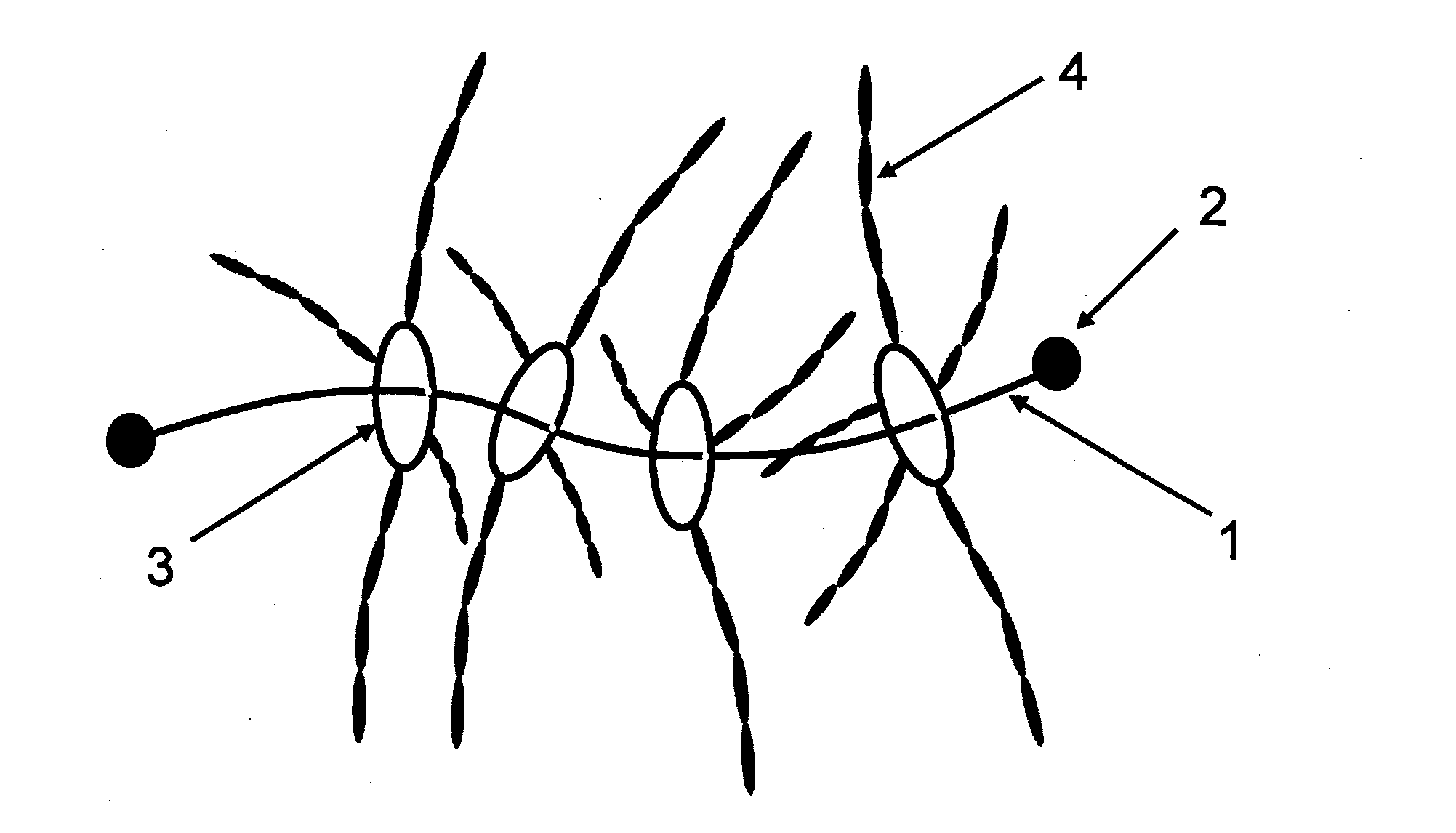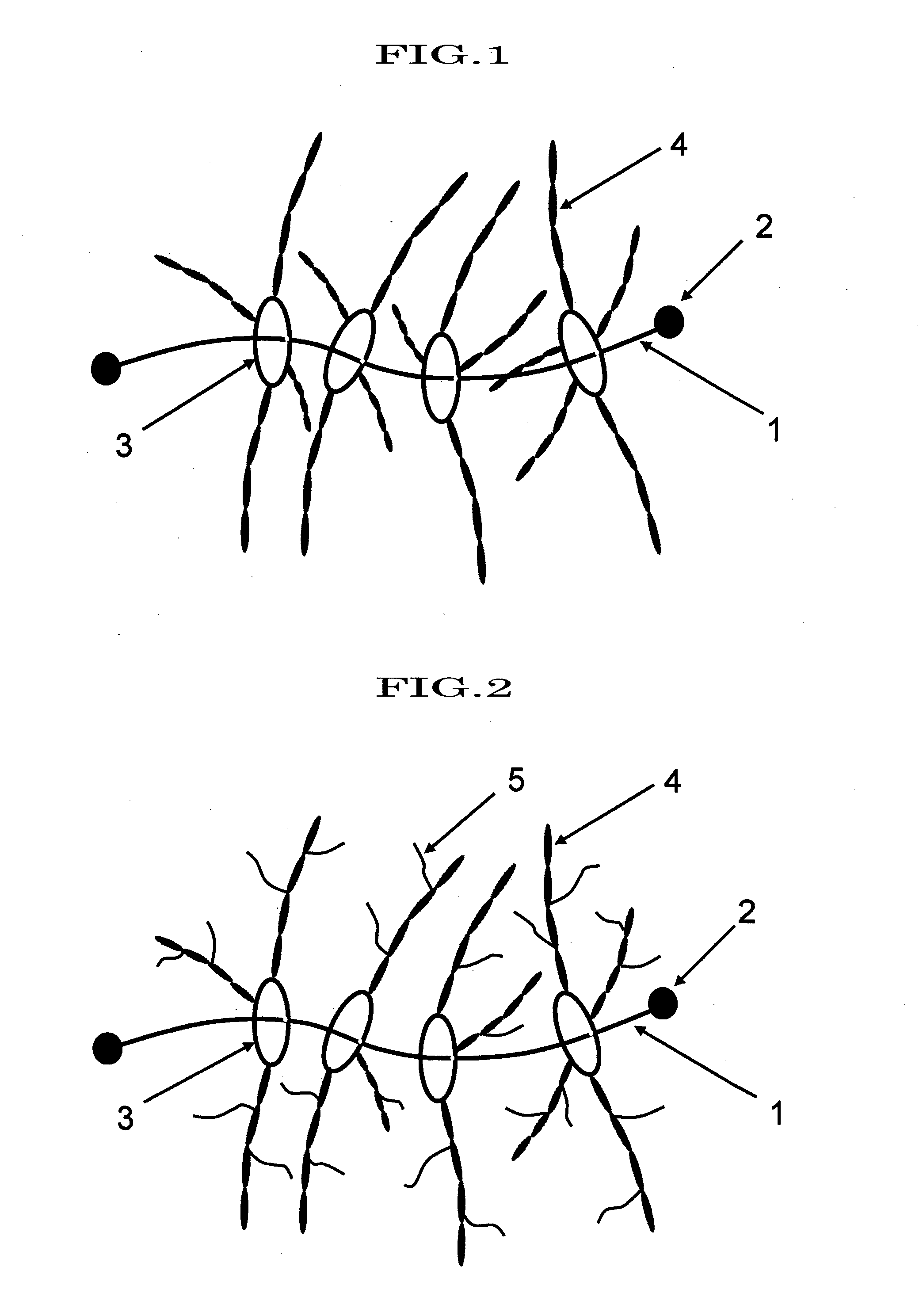Polyrotaxane, crosslinked structure comprising polyrotaxane and polymer, and processes for producing these
a technology of polyrotaxane and crosslinked structure, applied in the field of polyrotaxane, can solve the problems of -temperature conditions to be used, -no disclosure nor suggestion, -polyrotaxane molecules may be crosslinked with each other,
- Summary
- Abstract
- Description
- Claims
- Application Information
AI Technical Summary
Benefits of technology
Problems solved by technology
Method used
Image
Examples
example 1
[0182]
[0183]A compound (hereinafter, abbreviating hydroxypropylated polyrotaxane as “HAPR35”) obtained by hydroxypropylating a polyrotaxane formed of a linear molecule: polyethylene glycol (average molecular weight: 35,000), a cyclic molecule: α-cyclodextrin (hereinafter, simply abbreviating “cyclodextrin” as “CD”), and a capping group: an adamantane amine group was prepared in a manner similar to the method described in WO2005-080469 (whole contents thereof are incorporated herein by reference) (α-CD inclusion amount: 25%).
[0184]35.50 g of the HAPR was measured and charged in a three-neck flask, followed by pre-drying and substituting with nitrogen. Thereto, 0.6 g of dimethylaminopyridine was added, and 50 ml of similarly nitrogen-substituted dimethyl acetamide (hereinafter, abbreviated as “DMAc”) was added and dissolved. In an ice bath, 7.6 ml (1.1 equivalent based on all OH groups in the polyrotaxane) of triethyl amine and 6.2 ml (1.0 equivalent based on all OH groups in the poly...
example 2
[0185]
[0186]A polyrotaxane EX-HAPR was obtained in a manner similar to Example 1, except that an amount of triethylamine was 1.5 ml (0.22 equivalents based on all OH groups in the polyrotaxane), an amount of 2-bromoisobutylyl bromide was 1.2 ml (0.25 equivalents based on all OH groups in the polyrotaxane).
[0187]GPC determined that weight average molecular weight, Mw, was 151,000, and molecular weight distribution, Mw / Mn, was 1.4. It was determined by1H-NMR that the degree of modification was 24%.
example 3
[0188]2.0 g of EX-HAPR (degree of modification: 47%) prepared in Example 1 was charged in a three-neck flask. After nitrogen substitution, 17.7 ml of methyl methacrylate (40 equivalents to the number of moles of 2-bromoisobutylyl group) was added thereto, and dissolved. Thereto, 5 ml of nitrogen-substituted DMAc was added, and stirred. Subsequently, 0.06 g of copper bromide and 0.13 g of 2,2′-dipyridyl as a catalyst were added and stirred at room temperature for 5 hr. After 5 hr, a reaction system was opened. After confirming that a reaction solution changed from brownish-red to green, suction filtration was performed by using silica as a filtration aid. The filtrate was dropped in methanol and a re-precipitation was recovered and dried under reduced pressure. An amount of the resulting product (Methyl methacrylate group-introduced EX-HAPR. Hereinafter, in some cases, abbreviated as “MM-EX-HAPR”) was 3.8 g. GPC determined that weight average molecular weight, Mw, was 720,000 and mol...
PUM
| Property | Measurement | Unit |
|---|---|---|
| temperature | aaaaa | aaaaa |
| temperature | aaaaa | aaaaa |
| molecular weight distribution | aaaaa | aaaaa |
Abstract
Description
Claims
Application Information
 Login to View More
Login to View More - R&D
- Intellectual Property
- Life Sciences
- Materials
- Tech Scout
- Unparalleled Data Quality
- Higher Quality Content
- 60% Fewer Hallucinations
Browse by: Latest US Patents, China's latest patents, Technical Efficacy Thesaurus, Application Domain, Technology Topic, Popular Technical Reports.
© 2025 PatSnap. All rights reserved.Legal|Privacy policy|Modern Slavery Act Transparency Statement|Sitemap|About US| Contact US: help@patsnap.com


